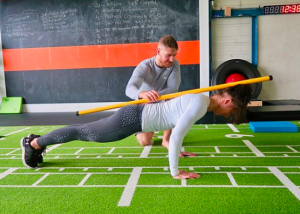As Many ”GOOD” Reps As Possible
Over the past year at MBSC we have seen an influx of athletes of a very low training age. This has forced us to go back over our program and look for ways to adjust in order to accommodate the new demographic.
The key for us was to make the program simpler without sacrificing the things we deem to be most important. Easier said than done.
Here’s what we did:
- First we defined what we considered “Important Qualities” for a young athlete. For us they are: sprint, throw, catch, jump, crawl, pick something up, carry it, squat it, put it over your head, push something heavy, balance on one leg, and have fun doing it! Very similar to the Cyclone Circuit created by TPI for their Junior Golf Program.
- We included a lot more eccentric & isometric work. Eccentric bench press, split squat holds, push up holds, TRX row holds, chin up holds & eccentrics, sumo squat holds, push/pull holds, anti-rotation holds. These work great for teaching correct positioning, patterning, and control.
- We’ve moved to doing more paired sets, instead of tri or quad sets. The simplicity of paired sets means fewer things to manage as a coach and less things for the athlete to remember.
- Rather than give the athletes two different workouts each week, we’ve changed to having them do the same workout twice a week to give them more exposures to each exercise. In a 10 week period they’ll do each exercise 20 times as opposed to 10, giving them more practice to learn and ingrain good technique.
“The importance of repetition until automaticity cannot be overstated. Repetition is the key to learning.”― John Wooden
To add to the list, we have most recently moved some of our exercises to an AMRAP (As Many Reps As Possible) rep scheme. More specifically the push up, but I’ve also applied it to chin ups, trap bar, goblet squats, RFE’s, and bench press. Whether you are a trainer or the trainee, you have most likely performed a set of AMRAP (As Many Reps As Possible) in one of your workouts. The problem here isn’t the idea of AMRAP itself, it’s the quality of reps you see when people are doing them. When you write xAMRAP on a white board, you’re issuing a challenge. The psyche of any athlete is to push themselves as hard as possible, which often comes at the expense of good form.

In an effort to promote good form we now program using the acronym AM”G”RAP. The “G” stands for good. By simply adding one letter, the entire context is changed. The emphasis changes from “how many reps can you do” to “how many GOOD reps can you do.
A set of AMRAP for a solid lifter of a high training age is much different than your average athlete or everyday fitness enthusiast. If you’ve spent years under that bar, have at it my friends. The problem is that 99% of the clientele that make up most gyms/Crossfits are average lifters or athletes of a very low training age (less than 2 years of training experience). When you’re training a beginner to get them to a certain level of competency, AMGRAP is the way to go. Too many programs and trainers call for sets of AMRAP with athletes or clients who have not earned the right to do so. Always seek quality over quantity.
I have also been prescribing AMGAP for all the homework & corrective exercise I give out at Movement As Medicine. Instead of assigning each exercise a set number of reps, I have the client go until they feel they can no longer maintain their form, or take another proper deep breath. If you get to 20 solid reps and breaths, then, and only then, can we move on to our next progression.
You must earn the right to move on.
Remember the golden rule: DO NO HARM. As fitness professionals and therapists who care about their client’s results and their longevity, let us start prescribing xAM”G”RAP more often.
This article was written by Movement As Medicine co-owner and CFSC Coach Brendon Rearick. He can be contacted at brendonrearick@gmail.com